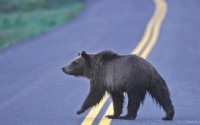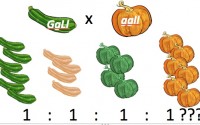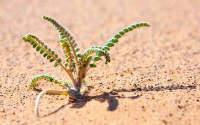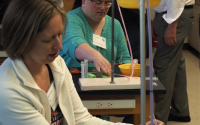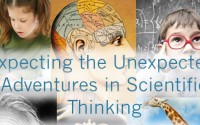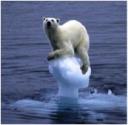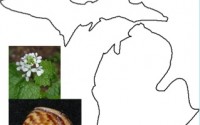Soil properties can often dictate the types of plants that can live in a particular habitat. The composition of soil affects everything from the amount of water available, to the types of nutrients and minerals present, to a plant’s root structure and growth. This lesson will focus its investigation on the particle sizes of various soil types. During this lesson, participants will look at sand, silt, and clay particles under a microscope and use this information to estimate the proportion of these components within various soil samples they have collected. They will also test the permeability of their soil and relate this to its makeup and particle size. Finally, plant adaptations to live in various soil types will be discussed, and a case study will incorporate data interpretation from a plant species that is adapted to live on a unique […]
Decomposition: The Ultimate Disappearing Act!
Decomposition is a complex process happening all around us. The goal is to identify where decomposition is happening (in the fridge in the forest), examine important factors – biological, chemical and physical, and used an inquiry-based approach for students to set up their own experiments At the conclusion of the lesson, students will be able to: Understand the concepts involved in decomposition – physical, chemical and biological. Connect these concepts with their everyday experiences and knowledge and relate them to models of food webs and carbon cycling. Use concepts to construct a decomposition experiment that unites the above concepts. Resources: Lesson plan Powerpoint Worksheet Excel template (and example) for graphing Activity guide Lesson plan created by fellow Brendan O’Neill and partner-teachers Jodie Lugar-McManus and Jennifer Boyle, 2014
Connecting Landscapes in a Changing World
Changes to landscapes as a result of human activities often result in habitat fragmentation. Habitat fragmentation not only results in smaller habitat patches and greater distance between those patches, but can also affect movement of organisms between the remaining fragments. Decreasing the ability of organisms to move between patches can have negative effects on the population, as well as potentially threatening the long-term persistence of a given species. Designing reserves and connecting existing habitat patches are a couple ways to mitigate the negative effects of habitat fragmentation. One means that is used to connect habitat fragments is the establishment of landscape corridors. Landscape corridors are areas of land between habitat fragments that are used to promote the movement of organisms between patches. Corridors can take on a number of shapes and forms, which depend on the movement requirements of the […]
Why do species cooperate? A card-based simulation of the ant-acacia mutualism
All species interact with other species in their community. Some types of interactions are antagonistic, where one species benefits at the expense of another- such as predators and prey, or parasites and their hosts. However, interactions between species may also be mutualistic, where both species benefit from interactions with one another. Examples of mutualisms abound in nature, such as pollination, cleaner fish, and gut bacteria. Interacting species are constantly co-evolving. Predators may become faster to overcome their prey, while the prey get better at dodging attacks. Likewise, in cooperative interactions, each species is under selection to obtain the most benefit from the interaction at the lowest cost. Since cheating may have immediate benefits to an organism, it is difficult to understand how mutualisms evolve and remain stable through time. This lesson explores the circumstances that favor the evolution of cooperation, […]
Coevolving with Crossbills: A Tale of Two Pinecones
Interactions between species can lead to coevolution. Even the interactions we observe in our own back yards, be they predator-prey interactions, species competition, or mutualism, can lead to two species reciprocally affecting each other’s evolution. In this lesson, students will learn about species interactions that lead to evolutionary arms races, using coevolution between crossbills, lodgepole pines, and red squirrels as an example. The lesson includes an activity to illustrate coevolution in action and a graphing activity. At the conclusion of the lesson, students will be able to: Define coevolution Identify and explain the types of species interactions that lead to coevolution Produce frequency distribution graphs that display coevolution between two species over time Resources: Lesson plan Powerpoint Graphing activity worksheet Graphing/data recording spreadsheet (.xlsx) Spreadsheet instructions Lesson Plan created by GK-12 Fellows Brendan O’Neill, Susan Magnoli, and Andy Booms, 2014
Not in my stream! The Asian carp invaders
In this lesson, students will learn about watersheds, freshwater food webs, and invasive species through a power point presentation, a matching/coloring activity and a board game. First, we will introduce students to the concepts of watersheds, food webs and invasive species. Then we will introduce the Asian Carp, an invasive species that could become a threat to the Great Lakes watershed by traveling up the Mississippi River. Students will fold, match, and color a worksheet that shows an aquatic food web with and without Asian Carp. We will discuss what differences they find and how those differences could have ecological and social effects beyond the scope of the worksheet. Next we will discuss with the students how plants and animals are not static, that is, they can change their strategies to adapt to changes in their environment. To illustrate this […]
The Chi-square goodness of fit test: Application for testing genetic inheritance hypotheses
The Chi-square goodness of fit test can be used to test whether observed data are different from expected values based on a hypothesis. This test and lesson is a good introduction to statistical analysis of biological data for high school students. They will test their hypotheses with data and make scientifically rigorous conclusions. At the conclusion of the lesson, students will be able to: Formulate a hypothesis to test. Calculate expected values to test based on their hypothesis. Calculate the Chi-square value using a Chi-square table. Find the probability range for their Chi-square value and decide to support or reject their hypothesis based on the probability range. Resources: Lesson plan Powerpoint Chi-square student packet Chi-square teacher packet Lesson Plan created by GK-12 Fellow Bonnie McGill, 2014
Putting Down Roots: The Evolution of Plants from Water to Land
Plants play a major role in the lives of other living things, especially humans. But it’s worth taking a look at how plants as we know them came to be, and where they came from. What adaptations allowed the first plants to survive on land? How are the crops that make their way to our dinner tables different from their aquatic ancestors? In this lesson students will learn about the different adaptations that led to mosses, ferns, gymnosperms, and angiosperms. They will also have the opportunity to work hands-on with plant/algae samples to identify some of these adaptations and see where the samples fit along the evolutionary timeline. At the conclusion of the lesson, students will be able to: Identify the four main groups of terrestrial plants and list their evolutionary order Describe the key adaptations that distinguish terrestrial plant […]
Seeing the forest from the trees
What controls the structure of forests and the leaves within that forest? Individual leaves have very different shapes and even colors, but together they make up the forest canopy that traps light and water. This lesson aims to help students understand how the form of leaves and trees follows from the function of how plants use light and water. At the beginning of the class, instructors will lead a discussion on what trees need to grow. Students then will work individually on certain leaf types to understand how their shape influences their function; – this may involve collecting leaves, but also cutting out the shape of leaves or tracing the outline that the leaf shadow makes. Finally, students will see how the ways plants supply water to leaves interact with the capacity to capture light to influence leaf size. At […]
Farming for Ecosystem Services
In this lesson students will explore the relationship between biodiversity and ecosystem services, from basic ecological theory to their economic value. Provided with a short introduction to the types of ecosystem services and their importance, students will play a game where they must make decisions regarding how to invest a limited amount of money on their own for-profit farm—can they manage economic and ecological tradeoffs to design a productive farm that also enhances ecosystem services? At the conclusion of the lesson, students will be able to: Define “ecosystem services” and explain the difference between supporting, provisioning, regulating, and cultural services. Compare and contrast “ecosystem services” and “ecosystem function” and explain the importance of each Using evidence obtained from a classroom activity, explain the biodiversity-ecosystem function hypothesis Justify decision-making in a farming simulation as decisions relate to economic and ecological […]
Expecting the Unexpected: Adventures in Critical Thinking
How do we know we can trust a source or a claim made by someone? What constitutes “good science”? Knowing the answers to these questions is an important critical thinking skill for all students and is even more important in this digital age where students are exposed to information from many different sources with varying degrees of accuracy and qualifications. Everyone, including your students, is constantly facing confusing news stories and conflicting data and evaluating these claims requires the ability to think critically about all the information being thrown at them. This lesson contains activities that you can do with your middle and high school students to teach them critical thinking skills such as the importance of attempting to disprove a hypothesis, using hypotheses to make testable predictions, and examining a recent case of “bad science” that has resulted in […]
Geeked About Beaks: Inquiry learning about survival and reproduction
In this lesson, students will learn about survival, reproduction, selection, adaptation, and evolution all while playing hands-on games and constructing their knowledge through experience. Students get to be birds and compete against their classmates to eat the most seeds. This activity demonstrates how small beaks are better at getting small seeds, whereas large beaks are better at getting large seeds. Next, students become part of a bird population with a variety of beak sizes. Depending on the weather, big, small, or medium seeds are common that year. Students observe how populations change over time based on the environment. Students explain why the population changes over time, and they also make predictions about what will happen to the population in future years. At the conclusion of the lesson, students will be able to: Describe how physical characteristics of an organism affect […]
The Hunger Games: Hiding in Plain Sight – Exploring evolution using mimicry
Evolution is one of the most fundamental concepts in biology. The process of evolution by natural selection has produced some of the most spectacular traits found in living organisms. In this lesson students will explore the concept of evolution by natural selection using mimicry as an example. Mimicry refers to a similarity between more than one species for the purpose of protection. For example, a non-poisonous species may closely resemble a poisonous species, and this resemblance protects the non-poisonous species from predators. In this session, students will play a scavenger hunt game using Easter eggs to demonstrate the benefits of mimicry and the conditions under which mimicry can evolve. At the conclusion of the lesson, students will be able to: Understand the process of evolution by natural selection and be able to identify/explain its three components Understand that populations evolve, not […]
Invasive Species Game
In this lesson and game, students will learn about invasive species in Michigan, characteristics that make species good invaders, factors that can influence plant community assembly, and the role that people play in causing and proliferating invasions. At the conclusion of the lesson, students will be able to: Provide examples of invasions causing economic and ecological concerns in Michigan Identify characteristics (traits) that are common among many invasive species Present information on the role that people play in the establishment and spread of invasive species Recognize some common native and invasive plant species in Michigan Talk about populations, communities, and the niche Resources: Invasive Species Game – Lesson Plan Invasive Species of Michigan – Intro Powerpoint Species Cards – to make your own copy of the game Event Spinner & Stage Signs – to make your own copy of the […]
Why is there variation in personality type? Does fishing impact the variation?
Students simulate bass populations with and without fishing pressure, gather data from the simulation, analyze it by making graphs, and draw conclusions about what maintains variation in personality type and how fishing could cause evolutionary change in personality in populations that are fished. At the conclusion of the lesson, students will be able to: List the three requirements for evolution by natural selection Phenotypic variation in a trait exists within a population The phenotypes must be heritable Some phenotypes have higher fitness than others Determine whether evolution happened in a given situation and how it happened. Explain potential ecological and evolutionary effects of not using natural resources in a sustainable manner Resources: Lesson Plan Worksheet Selection on Personality Presentation
It’s Gettin’ Hot in Here!: Consequences of Climate Change on Flora and Fauna
While public policy on climate change continues to be debated in local and national governments, the effects of global warming are already being felt by many different plant and animal populations. Rising temperatures can directly impact plant and animal populations by causing range shifts as species are forced to move into areas with temperatures they can tolerate. In the process of shifting home ranges different species that were previously isolated from one another may come in contact, leading to new biotic interactions (whether they be predator-prey, host-parasite, or resource competitor interactions). In this lesson, students will be introduced to the basics of climate change research. Specifically, focusing on the impact climate change will have on the plant and animal populations. We will investigate a number of specific aspects that will be directly impacted through climatic changes, with a number of […]
Why fly south? How climate change alters the phenology of plants and animals
The timing of recurring life cycle events for plants and animals, like flowering and migration, are largely determined by cues organisms take from the climate. Scientists who study phenology, or the timing of these natural events, are interested in how climate change, particularly rising global temperatures and unpredictable transitions between seasons, will influence the timing of phenological events. For example, what can we expect to happen to the migration timing of birds, the mating season for animals, or the flowering times in plants? Further, how might abiotic seasonal changes like melt dates for lakes and rivers respond to climate change? To answer these questions, scientists turn to long-term datasets to examine whether shifts in phenological events are occurring over extended periods of time. Long-term datasets are extremely useful because scientists can examine average trends in timing shifts over periods of […]
The climate is changing…but will it change me?
This lesson takes a look at some of the ways that climate change may directly affect the life of a Michigander. It includes several opportunities for discussion about student’s observations and their connection to data. Using an internet-based weather forecasting tool for Michigan, students will complete an activity that allows them to visualize how several climatic changes will affect their lives. At the conclusion of the lesson, students will be able to: Describe three different climatic changes that scientists are predicting for Michigan Provide examples of how those changes will affect their and their families day-to-day lives Draw conclusions based on maps and simplified data (For more advanced students) Use internet tools and data to make predictions about additional climate scenarios Resources: Michigan climate change lesson plan Changing climate powerpoint Michigan climate change activity pages Internet resources Lesson written and […]
The New Farmer’s Almanac: Agriculture and Climate Change
In this lesson, students learn about the difference between climate and weather and how we expect Michigan’s climate to change. They use real data from the Kellogg Biological Station’s agricultural Long Term Ecological Research site to predict how specific crops may respond to climate change. At the conclusion of the lesson, students will be able to: Explain the difference between climate and weather Name three ways the Michigan climate is expected to change Show how some crops may improve with climate change while others decline Resources: Lesson plan Agriculture and Climate Change powerpoint Student worksheet LTER Climate Change data (Excel file) Lesson written and created by GK-12 fellows Tomomi Suwa and Anne Royer, 2012
Natural Selection in the Classroom
Semester-long projects that will allow students to see evolution in action In this lesson, teachers explore potential semester to year-long evolution lessons that will enable the development of classroom lessons about evolution by natural selection. These lessons consist of long-term studies where change in populations over time is observed rather than simulated. At the conclusion of the lesson, teachers will be able to: Develop a long-term natural selection lesson for the classroom Plan for the effective measurement of traits and fitness Discuss and teach the 3 requirements for evolution by natural selection: phenotypic variation, relationship between a trait and fitness, and heritability of the trait. The lessons discussed are designed to be semester to year long, long term, experiments. The long duration is necessary in order to see a response to selection. This lesson is intended for either an Intro […]
Water in the Classroom: Lake Mixing
Ever wonder why when you dive in a lake, there is a sudden drop in temperature? Russ Stolberg’s 8th grade Earth Science students have been discussing why we observe this phenomenon in our lakes and oceans. It all has to do with density! Cold water has a higher density than warmer water, and as solar radiation continually warms the surface of our lakes it makes this separation even more pronounced. I [Jake] had the pleasure working with the students on an exciting lab simulating how waters can become layered, or stratified, and then simulate how this stratification can be broken down through natural processes. Groups of students each got to work with their own pond (a clear plastic tub), which was heated by the sun (a heat lamp) and received warm wind via a blow dryer. We started with “Winter” […]
Michigan’s Most Unwanted: How to identify Michigan’s invasive species and why we should worry
How do we identify invasive species, and why do we care? In this lesson, students learn to make and use dichotomous keys to identify common invasive species. Students will gain an appreciation for why invasive species are important through a series of discussions, videos, and keying activities. A graphing activity will allow students to make graphs, interpret data from graphs, and draw conclusions based on data. At the conclusion of the lesson, students will be able to: Make and use simple dichotomous keys to identify species Discuss why species identification skills are important to understanding and preventing invasion. Convert a data table into a figure and draw conclusions Interpret a figure and discuss ecological explanations for the data shown Resources: Lesson plan Powerpoint presentation Graphing Activity (worksheet) Jelly Bean Key News Article 1 News Article 2 Lesson Plan created by […]
Survivor: Extreme Environments: How invasive plants outwit, outplay and outlast their competitors
This lesson plan provides a simple introduction to the mechanism of natural selection for students who are already familiar with concepts such as ecosystems, species, and variation. The lesson includes a short walk (can be done with nature photos) to identify the types and scales of variation in the natural world. Students then work in groups to adapt organisms (seeds) to different environments (soil types) in a fun, interactive exercise. Once seeds are well adapted to their environments, students will try to determine what made some of the organisms better than others, and try to predict how a new seed type will fare. The entire lesson is framed around how adaptions may help invasive species, but is equally applicable to native species. Teacher scripts are provided for the lesson introduction and accompanying power point. This lesson would be appropriate in […]
Roid Rage: Is It for Boys? How “true” are gender stereotypes?
Using a critical reading exercise and discussion, students will explore the perceptions and realities of sex differences in behavior, the causes of these differences. They will then use spotted hyenas, an unusual African mammal with a primate-like social system, to explore how scientists learn about individual and sex differences in aggressive behavior. The lesson will end with an activity that allows students to act as behavioral researchers. The lesson can be divided into three portions which can easily be made to stand alone, so teachers can do any and all portions as time permits. At the conclusion of the lesson, students will be able to: Read science presented in the media with a critical eye Consider the causes of variation in animal and human aggression Become more familiar how scientists study behavior Learn about current research in spotted hyena behavior […]
Variety is the Spice of Life! Why genetic variation is important
Variation is all around us in nature and genetic variation underlies these phenotypic differences among individuals. Natural selection acts on this genetic variation. It is important for populations of organisms to have genetic variation so that they are able to respond to changing conditions such as climate or predators. In this lesson students will learn why genetic variation matters if selection changes through time and get a hands on demonstration on how alleles make up the genotypes in a population. At the conclusion of this lesson, students will be able to: Understand genetic drift Understand why genetic drift has larger effects on small populations than large populations Explain the terms “heterozygous” and “homozygous” Be able to calculate genotype frequencies from allele frequencies using the Hardy-Weinberg equilibrium equation Explain why genetic variation is important for a population’s long-term persistence Resources: Lesson plan […]
Developing Research Questions Using BEST Plots
The BEST plots are an excellent system for introducing more opportunities for scientific inquiry into the classroom. While there are many teaching opportunities that arise from simply carrying out the data collection that allows us to address our broad questions (can we maximize productivity while still maintaining biodiversity?), students should ideally also be using the plots to develop research questions and experiments of their own. This lesson and the accompanying worksheet provide a useful tool for helping students and teachers (who may not have much previous experience) identify interesting questions and develop hypotheses using the BEST plots. This lesson also allows students to practice the steps of the scientific method prior to physically carrying out an experiment and can easily be used even if students can’t access a BEST plot. At the conclusion of the lesson, students will be able […]
Algal Biofuels: An Emerging Renewable Energy
In this lesson, students will explore the basic living requirements of algae (aka phytoplankton) through hands-on experience and an interactive game. We will investigate what algal biofuels are, how they are made, where they can grow, and, most importantly, why this topic should be investigated. The lesson is constructed with 2 short presentations, an optional water sampling event, identification of common phytoplankton, and a team outdoor game. At the conclusion of the lesson, students will be able to: Explain what phytoplankton are and what they “consume” Gain compound microscopy experience Identify some common phytoplankton species Explain the importance of bioenergy in contrast to fossil fuels Describe the benefits of biodiversity, and define community ecology Be excited about microorganisms Resources: Algae Biofuel Lesson Plan Phytoplankton Preview Powerpoint Phytoplankton Preview Key This lesson was created by KBS GK-12 Fellow […]
Cannibalism: Is it ever a good idea?
In this lesson, students explore how different competitive strategies will affect how well organisms survive in a population. Students will play a game simulating several strategies in different environmental conditions (including cannibalism!), collect data from the game, and use these data to draw conclusions about the success of their strategies. The results of the game can be used to discuss how kin selection may influence evolution. At the conclusion of the lesson, students will be able to: Graph their data and draw conclusions based on their results Explain how environmental conditions impact the success of different evolutionary strategies Explain how kin selection might affect evolution in a population Resources: Cannibalism Lesson Plan Accompanying Powerpoint Presentation Cannibalism Rule Sheet Cannibalism Worksheet The lesson was created by GK-12 Fellow Sara Garnett, 2012
Angry Birds: Exploring Behavioral Trade-offs
Animals have limited supplies of energy and often must choose which activities to focus on at the expense of others. In this activity students will play a game that explores the trade-off between aggression and parental behavior. In part A, students will explore the role of aggression in acquiring a territory. In part B, students will explore the trade-off between parental behavior and aggressiveness and learn there are multiple ways to be successful. At the conclusion of the lesson, students will be able to: Explain how aggression impacts an organism’s success. Explain how environmental characteristics shape the benefits of aggression. Explain the tradeoff between aggression and parental behavior. Resources: Angry-birds-lesson-plan Angry birds- strategy cards Angry Birds-offspring cards Angry-birds-student-worksheet Angry Birds-Post Questions Answer Key Lesson created by GK-12 Fellow Cara Krieg
The Best Genes for the Job: Exploring genotype by environment interactions
An organism’s genetic composition plays an important role in its chances of survival, but will the same combination of genes always win? An organism, (or more specifically, a set of genes) that succeeds in one environment or season may not fare so well under different conditions. In this lesson plan, students will explore how genetics and environmental conditions can affect the survival of different organisms. This classroom activity simulates how birds with different beak sizes might have a competitive advantage depending on environment. Students will then graph their data to see how environment influences the success of different genotypes. At the conclusion of the lesson, students will be able to: Explain how survival of an organism is affected by both its genotype (nature) and its environment (nurture) Understand environmental factors that contribute to the varying success of organisms, including climate, seasonal […]
Mutualism in Action
Students will learn about the mutualistic relationship between plants and nitrogen fixing bacteria. The effect of environmental conditions on this relationship will be investigated in two inquiry activities. At the conclusion of the lesson, students will be able to: Define mutualism. Describe the mutualistic relationship between nitrogen fixing bacteria and legumes. (biotic interactions) Describe how changing environmental conditions can alter the relationships between organisms. (abiotic interactions) Resources: Lesson Plan Student Handout Assessment The American Biology Teacher paper based on this exercise Supplementary Material1: Student Worksheet on plant-rhizobia mutualism Supplementary Material 2: PowerPoint presentation on plant-rhizobia mutualism Lesson plan created by GK-12 Fellow Tomomi Suwa & teacher Sandy Breitenbach, 2012. Last updated: September 2015



